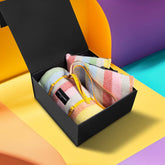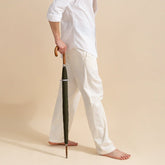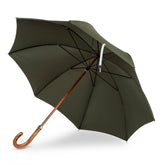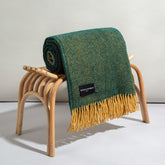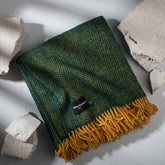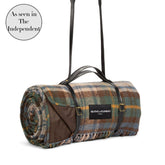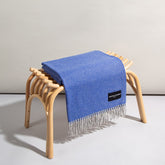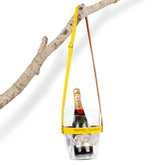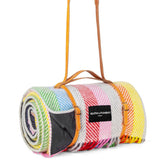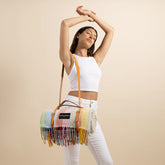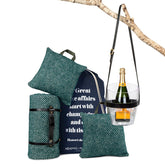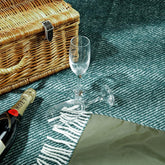Waterproof Outdoor Cushions: Buying Guide
Outdoor spaces, whether it's a sprawling garden, a cozy balcony, or a sunlit patio, are sanctuaries where we seek relaxation and respite. They are extensions of our homes, reflecting our style and personality. As we invest time and effort into making these spaces inviting, the furnishings we choose play a pivotal role in enhancing comfort and aesthetics.
See our pure new wool outdoor cushion selection
Among these, outdoor cushions stand out, not just for the softness they provide but also for the vibrant splash of colour and design they bring to the setting. However, the unpredictable nature of the outdoors, with its sudden downpours, dewy mornings, and occasional spills, demands that these cushions be more than just pretty.
They need to be resilient, durable, and, most importantly, waterproof. Investing in waterproof outdoor cushions ensures that your serene outdoor haven remains undisturbed by the whims of weather, offering both longevity and enduring beauty.
Why Waterproofing Matters
The allure of an outdoor space lies in its connection with nature. The gentle caress of a breeze, the warmth of the sun, or the rhythmic patter of raindrops all contribute to its charm. However, these very elements can be challenging for outdoor furnishings, especially cushions. Here's why waterproofing is non-negotiable:
Protection Against Unpredictable Weather: Whether it's an unexpected summer shower or a sudden cold snap, weather can be fickle. Waterproof cushions ensure that your outdoor seating remains dry and ready for use, no matter the forecast.
Extended Lifespan of Cushions: Moisture is a primary factor in the deterioration of cushion materials. By repelling water, waterproof cushions resist wear and tear, ensuring they look and feel great for longer.
Prevention of Mould and Mildew Growth: Damp cushions are breeding grounds for mould and mildew. These fungi not only discolour and weaken the fabric but can also pose health risks. Waterproofing prevents moisture retention, keeping these unwanted guests at bay.

Maintaining Aesthetic Appeal: Water stains, fading from excessive dampness, or damage from pooled water can mar the appearance of cushions. Waterproof variants maintain their vibrant colours and structural integrity, ensuring your outdoor space always looks its best.
Cost-Efficiency: While waterproof cushions might come with a slightly higher price tag initially, their durability means fewer replacements and repairs in the long run. This translates to savings and less hassle for homeowners.
Waterproofing is not just about repelling water; it's about preserving the beauty, functionality, and longevity of your outdoor cushions, ensuring that your outdoor retreat remains a source of joy and relaxation for years to come.
Types of Waterproof Outdoor Cushions
When it comes to outdoor cushions, not all are created equal. The term 'waterproof' can be a bit misleading, as there are varying degrees of water resistance. Understanding these differences is crucial when selecting the perfect cushion for your outdoor space.
Fully Waterproof Cushions
Materials Used: These cushions are typically made with a core of closed-cell foam and are encased in a waterproof fabric. The seams are often sealed to prevent any water ingress.
Pros: Offers the highest level of protection against water. Ideal for areas with frequent rainfall or for cushions that might be exposed to pool splashes.
Cons: Can be more expensive than other types. Some designs might lack breathability, leading to a warmer seating experience during hot days.
Water-Resistant Cushions
Difference between Water-Resistant and Waterproof: While waterproof cushions are designed to be impervious to water, water-resistant cushions can handle light rain or splashes but might not hold up well under prolonged exposure or heavy downpours.
Materials Used: Often made with fabrics treated with a water-repellent coating. The inner filling might not be fully waterproof, so it's essential to ensure they dry out after getting wet.
Pros: Generally more affordable and offers a broader range of designs and textures. Provides adequate protection for areas with occasional rain.
Cons: Not suitable for prolonged exposure to water. Might require more frequent maintenance and drying.
Pure New Wool Cushions
Natural Water-Resistant Properties: Wool has inherent properties that allow it to repel light moisture, making it a unique choice for outdoor settings.
Pros: Offers a natural and luxurious feel. Biodegradable and sustainable. Provides moderate water resistance while maintaining breathability.
Cons: Might not be as durable as synthetic materials when exposed to direct sunlight. Requires special care to maintain its water-resistant properties.
Materials Used in Waterproof Cushions
The efficacy of a waterproof cushion largely hinges on the materials used. From synthetic fabrics to natural fibres, each material offers unique benefits and challenges. Let's delve into some of the most popular choices:
Wool
Features and Benefits: A natural fibre, wool has inherent water-resistant properties. It can absorb moisture without feeling wet and can repel light rain. It also offers a luxurious and comfortable feel.
Care and Maintenance: Wool cushions should be brushed regularly to maintain their texture. For cleaning, use a mild detergent suitable for wool. It's crucial to dry wool cushions away from direct heat to maintain their shape and texture.

Polyester
Features and Benefits: Polyester is a versatile synthetic fabric known for its durability and resistance to mould and mildew. When treated with a waterproof coating, it becomes an excellent choice for outdoor cushions.
Care and Maintenance: Easy to clean with mild soap and water. It's essential to ensure that the fabric is completely dry before storage to prevent mould growth.
Vinyl
Features and Benefits: Vinyl is inherently waterproof and is often used for outdoor cushions in wet climates. It's also resistant to UV rays, reducing the risk of fading.
Care and Maintenance: Can be wiped down with a damp cloth. Avoid using harsh chemicals, as they can degrade the material over time.
Solution-Dyed Acrylic
Features and Benefits: This fabric is known for its colourfastness, as the dye permeates the entire fibre. It's resistant to UV rays, mould, and mildew, making it a top choice for outdoor settings.
Care and Maintenance: Can be cleaned with a mixture of mild soap and water. Rinse thoroughly and allow to air dry.
Olefin
Features and Benefits: Olefin, also known as polypropylene, is a lightweight, durable fabric. It's resistant to fading, staining, and moisture, making it suitable for outdoor use.
Care and Maintenance: Easy to clean with mild detergent and water. Ensure it's dried thoroughly before storage.
Selecting the right material is paramount to the longevity and performance of your outdoor cushions. While each material has its merits, consider factors like your local climate, the placement of the cushions (fully exposed or under a covered area), and your maintenance preferences when making a choice.
Factors to Consider When Buying Waterproof Outdoor Cushions
Durability
While waterproofing is essential to protect against moisture, it's equally crucial to ensure the cushion is UV resistant. This ensures that the cushion doesn't fade or degrade under the sun's rays. Additionally, the cushion should be able to withstand daily use, especially if it's placed in high-traffic areas, making tear and wear resistance vital.
Comfort
The thickness and firmness of the cushion play a pivotal role in determining its comfort level. While some individuals might prefer a firmer feel, others might lean towards plush, soft cushions. Moreover, especially in warmer climates, the breathability of the cushion material becomes essential. A cushion that allows air circulation can offer a more comfortable seating experience, preventing the sticky feeling that can arise on hot days.
Design
When it comes to design and aesthetics, pick colours and patterns complement your existing outdoor furniture and overall decor. If you're looking to give your outdoor space a fresh touch, consider incorporating current design trends. This can provide a modern and updated feel to your setting.
Maintenance
Opting for cushions that are easy to clean, either through removable covers or materials that can be easily wiped down, can save a lot of hassle. Additionally, consider your storage options for the off-seasons, such as winter or rainy periods. Some cushion materials might necessitate indoor storage, while others can remain outside if they're protected with a cover.
Price
While it might be tempting to opt for cheaper alternatives, it's essential to balance quality with your budget. Viewing cushions as a long-term investment for your outdoor space can shift the perspective. Sometimes, spending a bit more upfront for a high-quality cushion can result in savings in the long run, as these cushions tend to last several seasons without requiring replacement.
Tips for Maintaining Waterproof Outdoor Cushions
Maintaining your waterproof outdoor cushions is pivotal to ensure they remain in pristine condition and serve you well over the years. Proper care can extend their lifespan, keep them looking fresh, and ensure they continue to provide the comfort you desire.
Regular Cleaning
Even waterproof cushions benefit from regular cleaning. Dust, pollen, and other environmental particles can accumulate on the surface. Wipe them down with a damp cloth or, for deeper cleans, use a mild detergent solution. Always ensure they're thoroughly rinsed to remove any soap residue.
Proper Storage
If you live in an area with seasonal weather changes, consider storing your cushions indoors during the off-season. While they might be waterproof, prolonged exposure to harsh conditions can wear them out faster. If indoor storage isn't an option, invest in high-quality outdoor covers that shield them from the elements.
Periodic Checks
Over time, even the best cushions can show signs of wear and tear. Regularly inspect them for any damage, fading, or signs of mould and mildew. Addressing minor issues promptly can prevent them from escalating into more significant problems.
UV Protection
While many waterproof cushions come with UV protection, it's a good practice to place them in shaded areas during peak sun hours. This can prevent potential fading and extend the vibrancy of their colours.
Avoid Sharp Objects
Be cautious when using sharp objects around your cushions, such as scissors, knives, or gardening tools. Accidental punctures or tears can compromise the waterproofing and overall integrity of the cushion.
Air Them Out
Even waterproof cushions can benefit from a bit of airing out. If they've been exposed to a lot of moisture, such as after a heavy downpour, let them dry out in a well-ventilated area. This can prevent any potential mould or mildew growth.
In conclusion, while waterproof outdoor cushions are designed to withstand the challenges of the outdoors, a bit of proactive care can go a long way. By following these maintenance tips, you can ensure your cushions remain a cherished part of your outdoor sanctuary for many seasons to come.

























